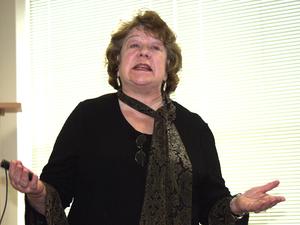Speaker uncovers African-American history

A frequently overlooked chapter of Nebraska history is being researched by the speaker at this week’s Phi Alpha Theta History Fraternity program at Chadron State College.
A former teacher, Vicki Toxel Harris of Cozad, said she found that African-Americans are usually not mentioned in the state’s textbooks. But she said there were several predominantly black settlements in Nebraska and these people she has studied were upstanding and possessed an array of skills.
Among those Harris told about was Moses Speese, a sharecropper who was continually being cheated by the owner of plantation where he lived in South Carolina following the Civil War. Moses was eventually smuggled off the plantation in a load of hay. He initially went to Indiana, where he worked long enough to send for his wife Susie and their children.
The family’s first stop in Nebraska was in Seward County, Neb., where Moses made a deal to farm a German immigrant’s homestead if the German would teach their children.
Harris said Moses and his brother, Jeremiah Shores, later built the Methodist Church in Westerville, located in eastern Custer County.
One of the largest settlements of African-Americans in Nebraska was along the North Loup River west of Brownlee in Cherry County. Harris reported that somewhere between 70 and 110 black families took out 640-acre Kinkaid homesteads in the area, “setting them up for failure,” in Harris’s words, because more land than that was needed to make a living in the Sandhills.
The African-Americans eventually possessed 50,000 acres of land, the speaker said. The community they founded was initially named Dewitty after the white postmaster. When he left, the name was changed to Audacious. While the black homesteaders did not succeed in ranching and the last ones left in 1936, the baseball team they organized was the region’s best, Harris reported.
Ida Morgan, a member of the Audacious community, was an Albino. She moved to Alliance and became one of that town’s best cooks, Harris said.
She also told of Robert Anderson, a former slave who took out a homestead northwest of Hemingford near Nonpariel and became a highly respected citizen in that community. She added that Anderson’s primary mistake was returning to the South when he was 80 and marrying a 22-year-old who spent most of his money.
Anderson’s niece married Hayes Chandler, who for years operated a horse-drawn garbage collection service, plowed gardens and was a popular figure in Alliance.
Harris said some of the first African-Americans in Nebraska were cowboys. She said Jim Kelly was a horse trainer, cook and amateur veterinarian for rancher/outlaw Print Olive in Dawson County and that Amos Harris was a foreman for large ranchers in the Burwell area.
The speaker said nearly all the blacks she has studied in the early Nebraska were “fine upstanding people who valued education for their children.”
Harris’s research has taken her to several states and Canada. She has made a tape of her stories and is planning to write a book.
Category: Campus News, Social Sciences
